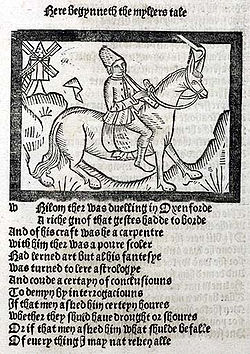
Back Middelengels Afrikaans Idioma anglés meyo AN Middelenglisc spræc ANG اللغة الإنجليزية الوسطى Arabic Inglés mediu AST Сярэднеанглійская мова Byelorussian Средноанглийски език Bulgarian মধ্য ইংরেজি Bengali/Bangla Krennsaozneg Breton Anglès mitjà Catalan
| Middle English | |
|---|---|
| Englisch, Inglis, English | |
 A page from Geoffrey Chaucer's The Canterbury Tales | |
| Region | England, some parts of Wales, south east Scotland and Scottish burghs, to some extent Ireland |
| Era | developed into Early Modern English, Scots, and Yola and Fingallian in Ireland by the 16th century |
Early forms | |
| Latin | |
| Language codes | |
| ISO 639-2 | enm |
| ISO 639-3 | enm |
| ISO 639-6 | meng |
| Glottolog | midd1317 |
Middle English or ME[1] is an older type of the English language that was spoken after the Norman invasion in 1066 until the 1500s.[2] It came from Old English after William the Conqueror came to England with his French nobles and stopped English from being taught in schools for a few hundred years. Over this time, English borrowed several Old French words and became part of the Anglo-Norman language. This period of the development was from the High Middle Ages to the Late Middle Ages.
In the 1470s, the Chancery Standard, a type of English spoken in London, started to become more common. This was partly because William Caxton brought the printing press to England in the 1470s. The type of English that people spoke in England between then and 1650 is called Early Modern English. There were many different dialects of Middle English.
Geoffrey Chaucer wrote The Canterbury Tales in Middle English.
- ↑ Horobin, Simon (2016). Introduction to Middle English. Edinburgh.
{{cite book}}: CS1 maint: location missing publisher (link) - ↑ Horobin, Simon; Smith, Jeremy J. (2002). An Introduction to Middle English. OUP USA. ISBN 978-0-19-521950-0.